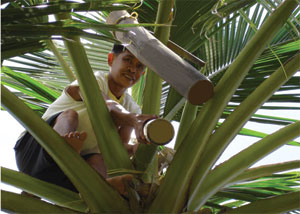No.1 Best "Voqu"Lambanog

Part of the Customs
In Quezon, drinking lambanog is usually a communal thing – men sit around in a circle and tagayan will ensue. The men take turns drinking shots from a cup placed in the middle of the group. Usually, there is also someone singing and playing the guitar to add to the festivities; he takes his turn at drinking too, so the music gets more interesting as the drinking goes on. It was made an export product in 2001 and has attracted foreign markets. To attract the youth and expand its marketing possibilities, it is now marketed and sold in different flavors such as cherry, jack fruit, apple, orange, four seasons, strawberry, bubble gum, mint, etc.
Process of Making
The lambanog making process is inexpensive and coconut trees are abundant in the Philippines. This made the lambanog to be coined as a “poor man’s drink”. Aside from that, making lambanog, the process itself, is an artistic expression that is distinct to the Filipinos. It has been a part of Filipino tradition for centuries.
The process of making lambanog starts with what was called the tree of life, the coconut tree. The flower from the tree, the space left by the flower is replaces by a tube made of bamboo. Daily, the people collect the nectars in the tube and it is being distilled to become lambanog. It seemed like the process of making lambanog is simple, but it is otherwise. A worker will climb up the tree about 30 feet high having a bamboo and sickle and getting the nectars from 35 coconut trees that was connected to each other by two long bamboo trunks. An expert can finish collecting nectars from 40 trees in 30 minutes. The nectars that were collected were put in a big plastic drum then when it is already full it will be transfered in a cooking pan and will be heated. The alcohol vapor is cooled and transfered into a large jar, and the lambanog is ready.
Flavored Lamabanog
To be able to make lambanog in a desired color, smell and taste, prunes were added to it. Some lambanog that can be bought in Manila has different flavors, like grapes and bubblegum.

No comments:
Post a Comment